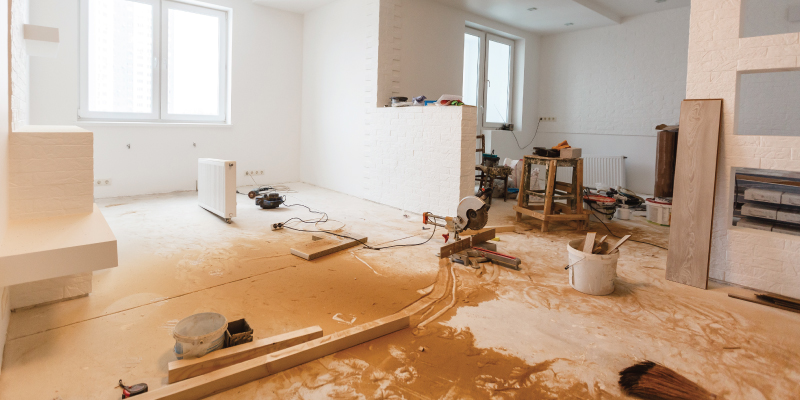
Updated January 26, 2024
Remodeling projects require careful planning and multiple steps and phases that should be done in order to ensure a smooth and seamless remodel process.
With each phase of a home remodel, you'll get closer and closer to the finished result and a more beautiful and enjoyable home.
Having a solid understanding of the demolition and remodel process will make it easier to know what stage your remodel is in, roughly how much longer it'll take, how the project is progressing, and how to keep the project running smoothly while staying in your budget.
In this article, we'll walk you through the multiple stages of a home remodeling project so you'll know what to expect.
The Demolition Phase Includes:
- Site Preparation and Safety
- Permitting and Compliance
- Utilities Disconnection
- Fixture and Appliance Removal
- Hazardous Material Abatement
- Demolition
- Salvage, Recycling, and Debris Disposal
Find interior demolition contractors near you
Naturally, there are a few steps that have to take place before demolition starts, like research, design, and choosing the best contractor for the job, but there are a few others that need to happen as well.
Below is a detailed breakdown of how the "demolition phase" of a home remodel will go, along with estimated average costs of each step
It's important to note that these cost estimates are general averages, and your actual costs may vary based on project specifics and regional factors.
Site Preparation and Safety
The first step to preparing the site for demolition is clearing the area and removing anything that isn't attached. This includes everything from furniture to appliances, decor, and personal items.
To keep the mess to a minimum, you or your contractor should take measures to protect areas that won't be demolished. This will prevent dust and debris from making their way into other areas of your home not being worked on, making cleanup when the project is done a much easier process.
Similarly, be sure your family is aware of which areas to avoid and implement any necessary safety protocols to keep the area being worked on clear.
Cost: This step may not have a specific cost associated with it, as it involves basic labor and preparation. However, if you need to purchase dust barriers yourself, you can expect to pay between $100-$200 on average.
Permitting and Compliance
Your contractor (or you—confirm this with the contractors you speak to) will need to obtain the necessary permits for the demolition work before getting started.
Demolition permits help the city keep a record of your home's structure and integrity, and it serves as evidence of building code compliance when the time comes to sell or refinance your home.
Cost: Permitting costs can vary based on location and project scope, ranging from $100-$1,000 or more on average.
Keep reading:
Utilities Disconnection
Another important step is disconnecting any utilities like gas, water, electricity, and HVAC systems.
Live utilities pose significant risks to workers and nearby residents if not properly managed. Turning off these utilities and capping/sealing them for safety helps minimize the risk of accidents, such as gas leaks, electrical shocks, or water-related incidents.
Cost: Costs for disconnecting utilities can vary, but budgeting around $500-$1,500 for this step on average is common.
Fixture and Appliance Removal
Now that all the important business is handled, it's time to start removing fixtures and appliances. This includes cabinets, countertops, sinks, built-in furniture, stoves, refrigerators, shower/tub, etc.
Remove cabinets, countertops, and built-in furniture. Extract appliances like sinks and stoves.
Cost: The cost for fixture and appliance removal can vary but is typically in the range of $500-$2,000 depending on the number and complexity of fixtures.
Learn more: How to Get Rid of Old Appliances
Hazardous Material Abatement
Next, any hazardous materials, like asbestos, lead, and mold, should be safely removed in compliance with regulations.
These types of hazardous materials can pose serious health risks to workers involved in demolition activities. Exposure to these substances can lead to respiratory issues, neurological problems, and other severe health conditions. Abating hazardous materials before demolition ensures a safer work environment for the demolition crew and any occupants in the home, too.
Cost: Asbestos abatement costs can range from $1,500-$3,000 per affected area, depending on the extent of the materials.
Find out more: How to Safely Remove Hazardous Wastes Before a Remodel or Demolition Project
Demolition
Now it's time for the serious demolition, like breaking down walls, removing ceilings, and taking out floors as needed for the remodel.
If the remodel involves structural changes, such as removing load-bearing walls or reinforcing foundations, the demolition process may require additional work and therefore take longer and cost more.
Cost: The cost of structural demolition can range from $2-$10 per square foot, depending on the complexity of the demolition and the structural elements involved.
Keep reading: The Homeowner's Guide to Interior Demolition
Salvage, Recycling, and Debris Disposal
With demolition producing debris, it's important to salvage any reusable materials and ensure recyclables get to the appropriate facilities.
Dumpsters are a great resource for managing the debris from a demolition or remodel project. With dumpsters, you can keep recyclable debris separated from general waste or debris that should go to a landfill. A steady flow of debris from the work site out to the dumpster will help keep the site and surrounding areas safe, too. With a clean and well-kept work site, the demolition and remodel can move smoothly and efficiently.
Cost: Salvage and recycling costs can vary. Salvaging materials may incur labor costs, while recycling costs depend on the type and volume of materials. A dumpster ranges from $250-$550 on average, depending on the size and volume/type of waste. Recycling dumpsters are often cheaper than dumpsters hauling debris to a landfill.
Learn more: Maximizing Recycling and Salvage Opportunities in Demolition


